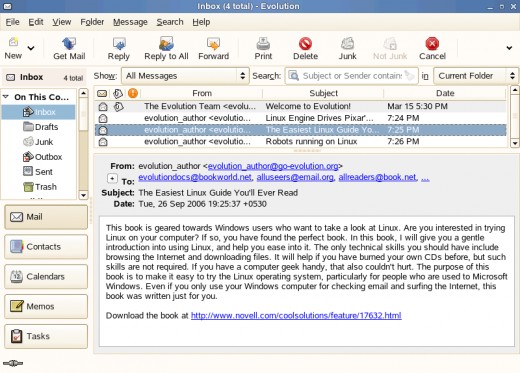Email Clients for the Linux Desktop

Microsoft Outlook, which is the most used email client, does not function on the Linux desktop. Now, this is not a big deal to most Linux users, as they migrated to Linux to get away from Microsoft. And with the popularity of webmail these days, many people are unaffected. But if you run a small business, have multiple email accounts, or simply want to store emails on your personal computer, there is a real need for a desktop email client.
Fortunately, there are plenty of option for Linux users. In fact, I would go as far to say there are more options for Linux users than Windows of Mac users. Because of the number of email clients available, it was impossible for me to try them all. Still, I believe there is something here for everyone. (If you're on the Windows platform, check out my hub Microsoft Outlook Alternatives for some Windows-based clients.)

Thunderbird
Thunderbird is the most used email client on this list, and for good reason. Not only is it available in every platform, but it is also the ultimate in customization due to its extensive stable of plugins and extensions. Both IMAP and POP email are supported, and encryption can be set up through plugins. Setup is easy, and if you are migrating from another email client, Thunderbird can make the move pretty painless.
The extensive plugin library is what makes this client so versatile. Want to sync with Google calendar and contacts? There's a plugin for that. Integrate with Google+, Instant messaging, and RSS Feeds? Yep, there's a plugin. Spam and add blocker? Got you covered. In short, just about any feature you could want in an email client can be added to this software.
Emails can be opened in tabs, so scrolling between several messages can be done quickly and easily. This also allows you to have email on a tab, RSS on a tab, and so on. The email layout can be switched between a three vertical column view (like MS Outlook), or a view with a single vertical and a split horizontal window.
My biggest gripe with Thunderbird is the dated appearance. Some may disagree with me, but I think we are long overdo for an overhaul. Wile you can download themes from Mozilla, these don't do much more than change font and color. I'd like to see something fresh and new.
Video Review of Geary
Geary
Author's note: I have an updated review of Geary on ariaprime.com. There is also a video review so you can see Geary in action.
Are you in the market for a sleek, modern-looking email client that is simple and easy to use? Then Geary may be for you. Developed by Yorba (the same company that created the photo manager Shotwell), this is the new kid on the block, and is designed for someone who wants a client that ONLY handles email. That's right... no calander, no task manager, no notes... just email. There is a simple address book, but not a true “contact manager” as in many other email clients.
The screen layout is three column, but the third column shows the email thread for the conversation. Each email in the conversation can be expanded or contracted, making for easy browsing through prior emails. For those who have an image linked to their email account (like in Gmail), the photo displays in the header of the email... a feature I really like. There is a row of icons along the top of the screen for functions such as “get mail” and “write mail”, and then a single settings icon. This leaves a clean, sleek interface with none of the clutter found in Thunderbird or some other email applications.
Setting up email is easy if you have a Gmail or Yahoo account. Any other account that supports IMAP can be configured, but be prepared to know a bit about your email server settings. Early versions of Geary only supported a single email account, but now multiple accounts can be added.
I really have no complaints about Geary. However, it is important to remember that this software is designed to do one thing only... read and write email. If you need other features, look elsewhere. And if you're someone who likes to tweak the appearance of your email client, then Geary is not for you. But if you want a simple to use, fast and light email program, try Geary.
Kontact
Kontact is the integrated personal information manager for the KDE desktop. Think of it as a Linux version of Outlook... on steroids. These programs form Kontact:
-
Akregator: RSS Feed Reader
-
KaddressBook: Contact Manager
-
Kjots: An idea notebook
-
KMail: Email Client
-
KNode: Usenet Mail Reader
-
Knotes: Note Taking app
-
KOrganizer: Calander and scheduling
-
KtimeTracker: Track time spent on various projects
-
Summary: Summary screen
As you can see, the feature of Kontact are quite extensive, and it would take too long to perform a full review of every component, so I will stick to talking about email.
The layout is traditional, with all of the most used functions laid out in a user-friendly fashion. Like everything in the world of KDE, there are options galore, which can be a double edged sword. While it is nice to have the ability to configure everything just the way you like it, the options are often overwhelming and difficult to implement. Going online and seeking help from other KDE users seems to be the best source of help, as the Kontact Handbook is poorly written and lack detailed instructions.
By default, Kontact displays html mail as plain text. This may be good or bad, depending on your preferences. There are also anti-spam functions, but it was extremely difficult to set up (once again, I had to go to the KDE community for help).
On the plus side, setting up Kontact is a breeze. And if you have lots of emails to import from another client, Kontact has a wizard that will walk you through the process. I imported my Thunderbird files without a hitch, although the process was time consuming (but in all fairness to Kontact, I have thousands of stored emails, some dating back to the mid 90's with my hotmail account).
Kontact has lots of funtionality and tons of options. Unfortunately, that means a pretty steep learning curve, especially if you want to use all of the available functions. As much as I liked having all of this funtionality at my fingertips, it was ultimately too time consuming for me to learn the ins and outs of every program included in this productivity manager. However, if you have a need for all of the features of Kontact and are willing to take the time to learn to use them, this can be a great productivity suite.
Video Review of Evolution

Evolution
Evolution is the default email client for most Gnome based distributions. While early versions of this client were slow and buggy, recent versions have have greatly improved responsiveness, and frequent crashes are a thing of the past. Support for all of the major email protocols are included, and you can set up multiple email accounts.
Of all of the clients reviewed, Evolution has my favorite interface. It is very fresh and modern looking, and can be configured for a variety of layouts. User images (such as those used by Gmail and Gravatar) are supported, so if you like to see who you're emailing (ME!), Evolution has you covered. There are a variety of plugins available for the program, but most are included with the installation package. And while Evolution can be highly configured, it has nowhere near the options that Thunderbird has.
Like Kontact and Thunderbird, Evolution is not simply email. There is a calander (which can be synced with Google Calander), a task manager, contact manager (which can sync with Google Contacts) and a memo pad.
My complaints with Evolution are relatively minor. I'd love to see tons of plugins like Thunderbird, although many of the Thunderbird plugin functions are already available by default in Evolution. I'd love to see a tabbed interface like Thunderbird. You can open multiple emails, each in their own window, but there is no way to organize or work with those windows. (I have dual monitors, and dealt with this problem by spreading out the windows between the two monitors. You could also resize the mail evolution window so that you have room on your screen for the multiple windows. But really, this is something the Evolution developers should deal with.)
In Conclusion
So what is the best email client? Really, it comes down to personal preferences and needs, as every program listed here is great in its own right. Thunderbird and Kontact get top nods for tons of features, while Geary gets two thumbs up for simplicity and high speed performance. I have personally made the switch to Evolution, as it gives me that “just right” balance of ease of use, great layout, and features. Of course, all of these clients are free, so there is no reason not to download them all and try them out.
(Author's note: I received a lot of emails on other email clients. I wrote a companion article titled More Email Clients for the Linux Desktop to cover some of these. Be sure to check it out!)
I hope you've enjoyed this hub. Which email client do you prefer? Let everyone hear about it by commenting below!



